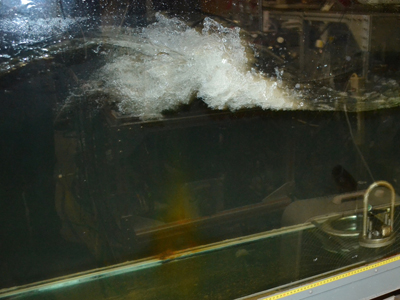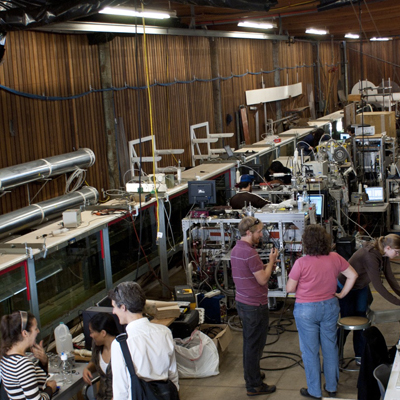Press Release: Unique Wave Flume Facility Allows Scientists To Study How Sea Spray Seeds Clouds
Ocean Wave Simulator Enables Researchers to Measure Sea Spray's Impact on Climate
Contacts: Jocelyn Duffy / 412-268-9982 / jhduffy@andrew.cmu.edu
Chriss Swaney / 412-268-5776 / swaney@andrew.cmu.edu
 PITTSBURGH—A great deal of attention has been paid to the environmental impact of what humans put into the oceans and what humans release into our air. But as waves crash, the ocean itself is releasing tiny particles into the air that can impact cloud formation and climate.
PITTSBURGH—A great deal of attention has been paid to the environmental impact of what humans put into the oceans and what humans release into our air. But as waves crash, the ocean itself is releasing tiny particles into the air that can impact cloud formation and climate.
Researchers at the University of California, San Diego, have developed a new method that for the first time accurately recreates sea spray aerosols — small airborne particles that are released into the atmosphere after ocean waves crash — in a laboratory setting. The method, which uses a 33-meter wave flume, allowed an international group of researchers, including Carnegie Mellon University's Ryan Sullivan, to study the chemistry of sea spray aerosols. Their findings are published online in the Proceedings of the National Academy of Sciences.
Aerosols, submicron-sized particles made up of things like fatty acids, inorganic salts and bacteria, waft up from sea spray and other sources into the atmosphere where, depending on their composition, they can seed clouds. This cloud seeding has a significant impact on climate - it can cause clouds to become "brighter," enhancing their ability to cool the earth, and it can cause clouds to produce rain or snow. The interaction between aerosols and clouds is complex, and researchers have been trying to develop new methods to help understand aerosol's impact on climate.
 "Interactions involving aerosol particles and clouds are one of the largest areas of uncertainty surrounding the study of climate change," said Sullivan, an assistant professor in the departments of Chemistry and Mechanical Engineering and a member of Carnegie Mellon's Center for Atmospheric Particle Studies. "Each water droplet in a cloud is formed around another seed particle. As we release different particles into the air through our day-to-day activities, we are changing the properties of clouds. We need to develop methods to better measure aerosols in order to better understand how they are impacting our climate and environment."
"Interactions involving aerosol particles and clouds are one of the largest areas of uncertainty surrounding the study of climate change," said Sullivan, an assistant professor in the departments of Chemistry and Mechanical Engineering and a member of Carnegie Mellon's Center for Atmospheric Particle Studies. "Each water droplet in a cloud is formed around another seed particle. As we release different particles into the air through our day-to-day activities, we are changing the properties of clouds. We need to develop methods to better measure aerosols in order to better understand how they are impacting our climate and environment."
A significant global source of aerosols is sea spray. When a wave crashes, it traps air bubbles beneath the water's surface. Those bubbles slowly rise to the surface, where a microlayer of organic material, including detritus from bacteria and other microbes, lives. The bubbles pop, emitting aerosols that can contain some of that organic material. The smallest particles waft up into the atmosphere.
Until now, it was hard to generate these sea spray particles realistically. Collecting samples in the ocean was difficult and uncontrollable, and laboratory simulations were unable to produce particles that were similar in size and composition to those that were found in nature.
The research group, led by UCSD Distinguished Chair in Atmospheric Chemistry Kimberly Prather, solved this problem using a device that is basically a long, narrow wave pool. The 33-meter long flume located at the Scripps Institution of Oceanography had originally been used by physicists to study the mechanics of waves. Prather and colleagues saw its potential for studying sea spray chemistry.
The device fills a chamber with water directly from the Pacific Ocean. A hydraulic paddle then sends sinusoidal waves down the flume where they hit a board, which causes the waves to crash. In this study, the researchers added organisms to the water, like bacteria, algae, or dinoflagellates, as well as nutrients, to simulate biological fluctuations in the oceans. They then used a variety of tools and techniques to measure the resulting sea spray particles.
Carnegie Mellon's Sullivan and Paul DeMott, a senior research scientist in Colorado State University's Atmospheric Chemistry Program, were responsible for studying the ice nucleation properties of the sea spray particles.
Most rain that falls over land begins as snow from frozen clouds that melts into rain before it reaches the Earth's surface. Glaciation, when the water droplets in the cloud freeze, can accelerate the onset of precipitation. But in order for the droplets to freeze, they must reach a temperature of approximately -38 degrees Celsius, far below freezing. Special particles, called ice nuclei, act as catalysts and allow the water droplets to freeze at warmer temperatures. Normally made of mineral dust or biological particles, ice nuclei are very rare, making up only 1 to ten of every million particles in the atmosphere.
To detect if there were ice nuclei in the sea spray, Sullivan and DeMott used an ice simulation chamber called a continuous flow diffusion chamber. They introduced sea spray particles to the chamber and exposed them to conditions that would normally cause the formation of an ice cloud. They found that the spray did contain ice nuclei. When the researchers changed the conditions by adding bacteria or phytoplankton to the wave simulator's water, the number of ice nuclei either stayed the same or decreased. Other researchers in the group similarly found that when biological matter was added to the water, it led to changes in the sea spray's liquid cloud-seeding ability.
"We really just scratched the surface," Sullivan said. "But we did see that if you change the biology of the ocean it has an impact on climate-influencing particles. As we're changing the ocean's temperature and acidity by emitting more carbon dioxide, we're changing the biology of the ocean and changing the sea spray aerosols that impact our climate."
Other authors on the paper include Timothy H. Bertram, Christopher D. Cappa, Douglas B. Collins, Luis A. Cuadra-Rodriguez, Sara D. Forestieri, Timothy L. Guasco, Matthew J. Ruppel, Olivia S. Ryder, Nathan Schoepp and Defeng Zhao of UCSD; Vicki H. Grassian, Andrew P. Ault and Jonas Baltrusaitis of the University of Iowa; Grant B. Deane, M. Dale Stokes, Lihini I. Aluwihare, Brian P. Palenik, Farook Azam, Lynn M. Russell, Craig E. Corrigan, Michelle J. Kim, William Lambert, Robin L. Modini and Byron Evans Pedler of the Scripps Institution for Oceanography; John H. Seinfeld, Scott P. Hersey and Wilton Mui of the California Institute of Technology; Ryan C. Moffet of the University of the Pacific; Mario J. Molina of UCSD and the Scripps Institution for Oceanography; Franz M. Geiger and Carlena J. Ebben of Northwestern University; Gregory C. Roberts of the Scripps Institution for Oceanography and the Centre National de Recherches Métérologiques in Toulouse, France.
The study was supported by a Center for Chemical Innovation award from the National Science Foundation that created the Center for Aerosol Impacts on Climate and the Environment (CAICE), and grants to individual researchers. Sullivan and DeMott were supported by a grant from the National Science Foundation.
###
Pictured above: The glass wave generator at the Scripps Institution for Oceanography allows atmospheric scientists to study the chemistry of sea spray particles. Images courtesy of the Center for Aerosol Impacts on Climate and the Environment.